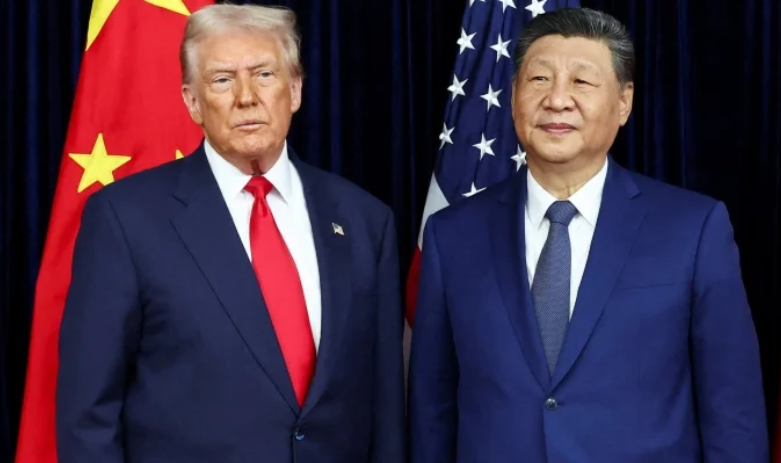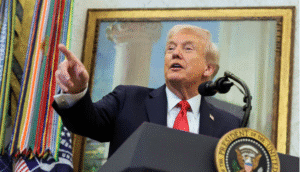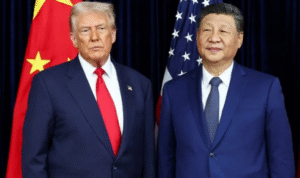Trump Lowers China Tariffs to 47% After “Remarkable” Meeting With Xi Jinping

Meta Description:
In a surprising turn of events, US President Donald Trump announced a tariff cut on Chinese imports to 47% after a landmark meeting with President Xi Jinping in Busan. The deal promises renewed soybean trade, continued rare earth exports, and cooperation on the fight against fentanyl trafficking.

A New Chapter in US–China Trade Relations
In one of the most significant diplomatic developments in years, United States President Donald Trump has agreed to cut tariffs on Chinese imports to 47%, following what he described as an “amazing” and productive meeting with Chinese President Xi Jinping.
The face-to-face discussion, held in Busan, South Korea, marked the first direct engagement between the two world leaders since 2019. Their meeting concluded a high-stakes Asian tour by Trump that included trade discussions with Japan, South Korea, and several Southeast Asian nations.
This decision marks a notable shift in the long-standing trade standoff between the world’s two largest economies — a dispute that has disrupted global supply chains, rattled markets, and altered investment strategies across multiple industries.
The Terms Behind the Tariff Reduction
According to President Trump, the reduction of tariffs from previous levels to 47% was part of a carefully negotiated exchange. In return, China has agreed to:
- Resume large-scale purchases of US soybeans, a key agricultural export hit hard by previous trade tensions.
- Maintain the export flow of rare earth elements, which are critical to industries such as defense, electronics, and clean energy.
- Crack down on the illegal trade of fentanyl, a synthetic opioid that has devastated communities in the United States.
Trump hailed the outcome as a “major win for both sides,” claiming it would bring stability back to global markets while strengthening agricultural and industrial cooperation.
Market Reaction: Global Stocks Turn Volatile
The news sent ripples through global stock exchanges, causing volatile movements across Asia, Europe, and the United States.
- The Shanghai Composite Index, which had recently reached a 10-year high, slipped slightly as investors digested the implications of the deal.
- US soybean futures weakened initially as traders awaited more details on China’s purchase commitments.
- Meanwhile, European and Asian markets swung between gains and losses, reflecting uncertainty about the long-term effects of the new trade arrangement.
Economists noted that while the agreement brought temporary optimism, investors remain cautious, especially considering the cyclical nature of US–China relations.
Inside the Busan Summit: A High-Stakes Dialogue
The two-hour meeting between Trump and Xi took place on the sidelines of the Asia-Pacific Economic Cooperation (APEC) summit in Busan. It was their first official encounter in over five years, and observers described the interaction as “tense but constructive.”
As they sat across from each other, Xi Jinping, through a translator, remarked that it was “normal for the world’s two largest economies to experience friction from time to time.”
Trump, for his part, emphasized the “need for fairness and reciprocity” in trade, reiterating his stance that previous US administrations had allowed “unbalanced” policies to persist for too long.
The session ended with a symbolic handshake, and Xi was escorted to his vehicle by Trump himself — a gesture analysts interpreted as a sign of mutual respect after a complex negotiation process.

A Year of Fragile Progress
The latest understanding follows months of back-channel diplomacy and quiet technical discussions between trade officials. Earlier this week, US negotiators hinted that a framework deal had been reached to prevent a 100% tariff on Chinese goods and to delay further restrictions on Chinese exports of rare earth minerals.
These materials — 17 elements vital for advanced technologies, from smartphones and electric cars to fighter jets — have been a central flashpoint in the trade conflict. China currently dominates more than 80% of the global supply, giving it substantial leverage.
Trump told reporters aboard Air Force One that the new deal effectively “settled the rare earth issue — at least for the next year.” He also expressed optimism that the agreement could be extended in the future, depending on progress made in enforcement and mutual compliance.
Rare Earth Agreement: A Critical Global Concern
The rare earth agreement may turn out to be the most strategic component of this new deal. Trump announced that China will continue exporting these essential elements without additional restrictions for the next 12 months.
“All of the rare earth has been settled,” Trump said. “And that’s not just for the US — this was a worldwide issue. There’s no roadblock anymore. Hopefully, that term disappears from our vocabulary for a while.”
These minerals are the backbone of modern technology, essential for manufacturing batteries, electric vehicles, semiconductors, and advanced weaponry.
In April, China’s decision to tighten export controls had triggered global shortages, forcing automakers and electronics producers in the US and Europe to slow or halt production. A partial easing of restrictions in July provided relief, but concerns resurfaced in October when China expanded its control list to include 12 rare earth elements and much of the equipment required to process them.
The Busan Agreement, as analysts are calling it, may temporarily stabilize supply chains and cool fears of further disruptions — though details of the enforcement mechanism remain unclear.
Crackdown on Fentanyl: A Win for US Public Health
Beyond trade and industrial policy, the agreement also includes a critical law enforcement and health component. Beijing has reportedly agreed to tighten restrictions on the production and export of fentanyl precursors — the chemical ingredients used to make the deadly synthetic opioid.
The move comes after years of pressure from Washington, which has accused certain Chinese suppliers of fueling the US opioid crisis.
Trump called this part of the deal a “life-saving step” and thanked Xi for taking “serious action on an issue that affects millions of American families.”
Health experts in both countries have welcomed the pledge, but warn that effective implementation will depend on consistent monitoring and cooperation between law enforcement agencies.
Agricultural Relief: Farmers Welcome the Soybean Deal
For American farmers, especially in the Midwest, the agreement could not have come at a better time. The trade war had significantly reduced US soybean exports to China, once the largest buyer of American soybeans.
The resumption of Chinese purchases could bring billions of dollars in renewed trade, reviving rural economies that have suffered since tariffs were first introduced in 2018.
The US Soybean Export Council released a statement applauding the decision, calling it “a strong step toward restoring stability in agricultural trade.”
Expert Opinions: Stability or Short-Term Relief?
Economists remain divided about the long-term implications of the tariff cut.
Some analysts argue that the move will bring short-term market stability but may not resolve deeper structural tensions between Washington and Beijing.
“This agreement looks like a truce rather than a peace treaty,” said Daniel Meeks, a senior trade analyst at the Brookfield Policy Center.
“Both sides have strong domestic political reasons to claim victory, but the underlying competition — in technology, defense, and global influence — isn’t going away.”
Others, however, see it as a turning point that could pave the way for a more predictable relationship. The hope is that continued dialogue will reduce uncertainty for global investors and industries dependent on US–China cooperation.
The Global Ripple Effect
The impact of the Trump–Xi agreement is expected to extend far beyond the two countries involved.
- Japan and South Korea, key players in global semiconductor manufacturing, may benefit from reduced tensions and greater access to raw materials.
- European automakers reliant on rare earth magnets could see supply chain relief.
- Developing nations in Southeast Asia may gain new trade opportunities as global production realigns.
Still, financial markets are likely to remain cautious. Investors have seen multiple “temporary truces” collapse in the past, and the durability of this deal will depend heavily on political will and global economic conditions.
The Road Ahead: Can This Agreement Last?
While Trump expressed optimism, stating that “this is just the beginning of a new phase in US–China relations,” some observers question how long the detente might last.
Both nations continue to compete fiercely in areas like artificial intelligence, military innovation, and geopolitical influence in the Indo-Pacific region. The agreement may ease immediate trade tensions, but deeper ideological and strategic rivalries are unlikely to disappear.
Moreover, enforcement remains a critical challenge. Neither side has released the full text of the agreement, leaving many to speculate on how disputes will be resolved if either country fails to meet its obligations.
Political Implications for Trump and Xi
Domestically, the deal gives both leaders something to celebrate.
For Trump, it represents a foreign policy win and a boost to rural voters ahead of upcoming elections.
For Xi Jinping, it demonstrates China’s ability to negotiate as an equal power while protecting its economic interests.
Analysts suggest that this mutual political advantage could help maintain the deal’s momentum — at least in the near term.
Conclusion: A Fragile but Promising Breakthrough
The Trump–Xi tariff reduction agreement is a rare moment of cooperation amid years of rivalry. It may not resolve every tension between the United States and China, but it does provide a framework for dialogue, trade normalization, and global market stability.
For now, both sides appear willing to prioritize pragmatic economic interests over political confrontation — a decision that could set the stage for further collaboration in technology, energy, and global governance.
As global markets cautiously adjust, the world will be watching closely to see whether this new phase of US–China relations marks the beginning of lasting peace or just another pause in a complex economic rivalry.







